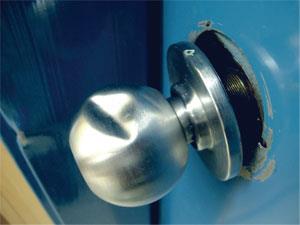By Daniel Grant
Opening her booth the second morning of an art fair, mixed-media artist Patricia Hecker of Bloomington, Ind., knew someone had been there the night before. Her artwork was OK, but the would-be thief had broken into a locked storage cabinet. “I’m sure [he or she] was looking for money,” she believes. Fortunately, she had been careful to take all cash and receipts back to the motel the evening before, so there wasn’t a loss on that end—just a damaged cabinet. Hecker mentioned the break-in to the fair sponsors, who had hired security guards and required each participating artist to sign a contract acknowledging that all property left on-site would be at the vendor’s own risk and not that of the show’s insurance company. Who would bother to file a claim anyways? The $1,000 deductible on Hecker’s policy far exceeded the value of the cabinet, “and if you report a claim they’ll just raise your rates,” she adds.
Thieves’ intentions
Thefts are an occasional, sometimes regular, nuisance for artists and craftspeople who sell their work at fairs and festivals, despite the sincere efforts of the event sponsors and the artists themselves to stop them. They take place at night, when the artists aren’t around, and during the day, when the artists are busy making sales and talking to potential buyers.
Some thieves, like Hecker’s intruder, look for money, while others may be more interested in the vehicle in which the art was transported. While his art was untouched, a drill was stolen from the tent of Gregory Reade, a La Jolla, Calif., sculptor, when he participated in a fair in Scottsdale, Ariz. David Bigelow, a printmaker in Ozark, Mo., says thieves have broken into his truck on several occasions, stealing the crates containing his etchings (he has no idea what the robbers assumed they were taking). The lesson he learned is, “Only eat at a restaurant where you can sit at the window and see your vehicle.”
 Other thieves simply want a piece of art without paying for it. “Two girls who had had too much to drink and had seen my work earlier in the day,” crawled under the tent of Michael Baker, a sculptor in Salisbury, N.C., during a show in State College, Pa., grabbing one of his statues. Walking back to their Penn State residence hall, they were spotted by a campus police officer, at which point they dropped the sculpture (it wasn’t damaged) and tried to get away. Instead, they and the sculpture were brought to the campus police headquarters, where their parents (and Baker) were called. “I was brought down and asked if I wanted to bring charges against them, but I didn’t want to do that,” Baker remembers. “The next day, the girls came to my tent, and I gave them a lecture on how stupid it was to do something like that while going to college. I hope they learned.”
Other thieves simply want a piece of art without paying for it. “Two girls who had had too much to drink and had seen my work earlier in the day,” crawled under the tent of Michael Baker, a sculptor in Salisbury, N.C., during a show in State College, Pa., grabbing one of his statues. Walking back to their Penn State residence hall, they were spotted by a campus police officer, at which point they dropped the sculpture (it wasn’t damaged) and tried to get away. Instead, they and the sculpture were brought to the campus police headquarters, where their parents (and Baker) were called. “I was brought down and asked if I wanted to bring charges against them, but I didn’t want to do that,” Baker remembers. “The next day, the girls came to my tent, and I gave them a lecture on how stupid it was to do something like that while going to college. I hope they learned.”
Precautions
No time of day appears more likely to see thefts than another; fair sponsors around the country state that reports of stolen items are too rare to make an analysis and insurers indicate that claims almost never take place. “We all know thefts happen, but we don’t really know with what frequency,” comments Sally Bright, board chairman of the National Association of Independent Artists. Her own experience of theft took place in the middle of a fair when a woman came into her tent, picked up an object and walked out with it. “I caught her in the act,” Bright adds.
There are different precautions to take during the day than in the evening. Bright recommends wearing your money (in a money belt), and not letting any cashbox, purse or register out of your sight. Having someone else in the tent, such as a friend or spouse, would provide another pair of eyes that could foil a thief, especially one who uses a partner to distract the artist. Art fair rules often prohibit the use of “proxies”—someone, such as a dealer, agent or relative, manning the booth in place of the artist—but a second person is generally allowed. Do not leave your tent unattended, and it would be unwise to ask neighboring exhibitors to watch your booth while you take a lunch or bathroom break. However, many fair sponsors offer “booth sitters,” volunteers who agree to relieve exhibitors for brief periods of time. However, these sitters don’t promote the artwork in the tent and are not allowed to make sales in the artists’ absence.
Protecting the contents of your tent overnight is less clear-cut. Fewer people are around to stop suspicious activity, and overnight security guards tend to be few in number. The two-day Greenwich Village Art Fair in Rockford, Ill., for instance, holds 120 tents on the gated grounds of a municipal park and is guarded at night by two police officers. “The police officers are armed,” informs Nancy Sauer, one of the managers of the Art Fair. Still, the odds are not in an artist’s favor. Store owners can lock their doors and pull down metal grates, but participants at fairs just zip their tents closed; even if they manage to put a lock on the zipper, the tent is just canvas. “In the early years of doing fairs, I used to remove works every day from my booth,” Hecker remarks. “The logistics were against me, though,” as it required her to bring her van to the site every morning and evening, unpacking and repacking. “When you handle the works so much, you’re very likely to cause damage, especially when you’re doing it at the end of a long day.”
The end of the day (or the end of the fair) also offers opportunities to thieves, who may have been looking at desirable objects in the booth and use the time that an artist is getting or loading the van to make a grab. Thieves also may have been paying attention to which artists sold the most on a particular day, following them out of the fair to get the cash. “You should stay in areas where there are other people,” Bright advises.
 Insurance policies
Insurance policies
Insurance policies that are relevant to artists and craftspeople come in two basic types:
Business owner, or general liability, policies provide property (business vehicle, fire damage, loss of equipment not including computers), medical and product liability coverage for artists in their studios and at an exhibition site (any damage caused to the facility). Art fair sponsors usually require vendors to have these policies, with liability coverage of at least $1 million. The deductible—the initial amount of money that an insurer is exempted from paying on a claim—is variable, ranging from $250 to $1,000, as is the level of liability ($300,000, $500,000 or $1,000,000). Policies with lower premiums usually have higher deductibles and lower liability limits.
Fine-art policies, on the other hand, simply insure the artwork—in one’s studio, in transit and at an exhibition. “Most of the time a loss takes place when the work is in transit,” explains Armanda Bassi of the Washington, D.C.-based insurer Flather & Perkins.
Some insurers offer a combination of business and personal property liability that covers artists while at home, in transit and when attending a fair. Unfortunately, this doesn’t completely take care of complications. RLI Corporation, which is based in Peoria, Ill., and offers combination coverage to artists and craftspeople in all 50 states, insures only home-based studios and not those that are off-site. “If where you work is more than 100 feet from your home, the risk for us becomes too great,” maintains Chris Alexander, an RLI agent.
Unfortunately for those who are insured, settling claims for theft and damage of artwork may not be quick and easy. This can even keep artists from filing a claim. “I tried to file a claim once, and the company said it wasn’t covered,” Bigelow says, adding, “I didn’t want to spend my time in small claims court, so I just gave up.” Insurers may require a condition report on pieces before they were shipped, photographs of both damaged items and the shipping boxes, as well as detailed estimates for repairs. Stolen items also need to be documented. Alexander notes that artists need to have taken “reasonable precautions,” such as locking their cars and zipping and locking their tents. If a thief crawls under a tent at night or shoplifts an item during show hours, RLI will “take things into consideration.”
Also, insurers frequently balk at paying full retail price settlements for objects that haven’t sold, requiring artists to present proof that similar items have been purchased for those amounts. Even with such proof, they may only be willing to pay a fraction of that amount. “We pay replacement costs—the cost of the raw materials and a reasonable hourly wage, for instance $20 an hour—but not the retail price,” Alexander remarks. And then there is a $250 deductible.
Unfortunately, for artists, losses from theft may never be recoverable. They appear to be just another part of doing business. Perhaps you should put your faith and money into vigilance and prevention.






